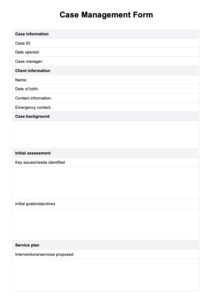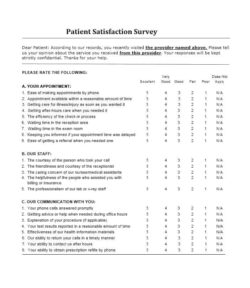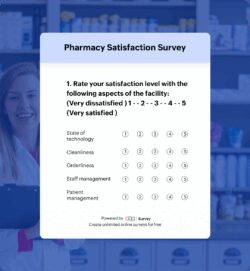Understanding what your patients truly feel about their experience within your hospital walls isn’t just a nice-to-have; it’s absolutely crucial for delivering top-notch care and fostering a reputation for excellence. Every interaction, from admission to discharge, shapes a patient’s perception, and those perceptions are invaluable for continuous improvement. Gathering this feedback systematically helps identify strengths to celebrate and areas that might need a little extra attention.
That’s where a well-designed patient satisfaction survey comes into play. It provides a structured way to collect honest feedback, ensuring that every voice is heard and every concern is noted. By using a standardized approach, you can track changes over time, compare performance across departments, and make data-driven decisions that genuinely improve patient outcomes and experiences.
Crafting an Effective Hospital Patient Satisfaction Survey Template
Building a survey that truly captures meaningful insights requires thoughtful planning. You want to ask the right questions in the right way to get comprehensive, actionable data. It’s not just about ticking boxes; it’s about understanding the nuances of the patient journey and identifying specific areas where you can shine even brighter. A robust hospital patient satisfaction survey template should cover the entire patient experience, from the moment they arrive until long after they’ve left.
Think about the different touchpoints a patient encounters. Did they feel welcomed upon admission? Was the medical staff clear in their communication? Was the environment clean and comfortable? These are all critical elements that contribute to overall satisfaction. Ensuring your survey addresses these diverse aspects provides a holistic view, helping you pinpoint exactly what’s working well and what might need tweaking.
When designing your questions, consider using a mix of rating scales, like a Likert scale (e.g., strongly agree to strongly disagree), to quantify satisfaction levels across various parameters. This allows for easy data comparison and trend analysis. For instance, you could ask patients to rate their satisfaction with nursing care, doctor communication, pain management, and even the quality of the food. These quantifiable responses become powerful metrics for performance improvement.
However, don’t forget the power of open-ended questions. While ratings give you numbers, qualitative feedback provides context and depth. Questions like “What could we have done better?” or “Please share any additional comments” often unearth invaluable insights that you might not have thought to ask about directly. This combination of quantitative and qualitative data paints a complete picture of the patient experience.
Key Sections to Include in Your Template:
- Admission Process: Ease of check-in, clarity of information, staff friendliness.
- Clinical Care and Staff: Nurse and doctor communication, attentiveness, empathy, pain management, explanation of treatment.
- Hospital Environment: Cleanliness, noise levels, comfort of rooms, quality of food.
- Discharge Process: Clarity of discharge instructions, understanding of follow-up care, feeling prepared to leave.
- Overall Experience: Likelihood to recommend the hospital, overall satisfaction.
Implementing Your Survey and Utilizing Feedback
Once you have your comprehensive survey template ready, the next step is putting it into action and, most importantly, leveraging the insights you gain. It’s not enough to just collect data; the real magic happens when you analyze that data and translate it into tangible improvements. A well-executed survey process can transform patient feedback into a powerful engine for organizational growth and enhanced care delivery.
Consider the various ways you can distribute your survey. Digital surveys sent via email or text message are often convenient for patients and allow for quick data collection. Paper surveys might be suitable for those less comfortable with technology, perhaps distributed at the time of discharge. Providing multiple options increases participation rates and ensures a broader representation of your patient population. Making it easy for patients to share their thoughts is key to getting robust feedback.
Encouraging participation is also vital. Clearly explain the purpose of the survey and how their feedback will be used to improve services. Sometimes, a simple thank you or a brief explanation of the impact of their responses can significantly boost completion rates. Patients are often willing to share their experiences if they believe their input will genuinely make a difference.
After collecting the responses, dedicate time to thoroughly analyze the data. Look for trends, common themes, and outliers. Are there particular departments consistently receiving lower scores? Are specific aspects of care frequently highlighted as areas for improvement? This analysis forms the basis for developing action plans. Share these findings with relevant teams and departments, fostering a culture of transparency and accountability.
Finally, the most critical step is to act on the feedback. Develop concrete strategies to address identified weaknesses and implement changes. For example, if communication about medication is a recurring issue, consider implementing new protocols for nurse-patient education. If wait times are a concern, explore ways to streamline scheduling. Regularly review the impact of these changes and communicate back to staff and, where appropriate, to patients, demonstrating that their voices are heard and valued.
By consistently gathering and acting upon patient feedback, hospitals can foster an environment of continuous improvement. This ongoing cycle ensures that care delivery remains patient-centered, responsive, and of the highest possible quality. It’s about building trust, enhancing reputations, and ultimately, providing the best possible experience for every individual who walks through your doors seeking care.


